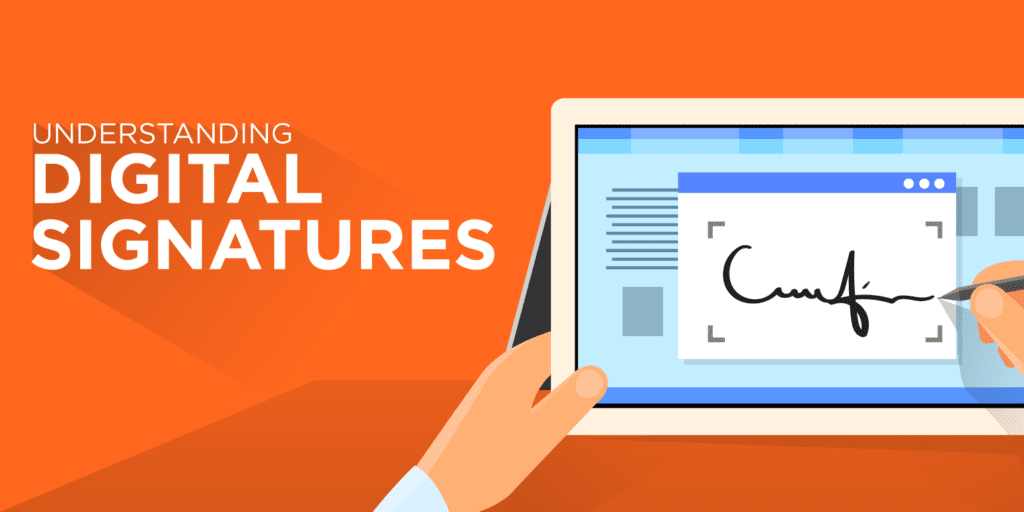Introduction
In the rapidly advancing digital age, where electronic transactions and online communication have become the norm, the need for secure and trustworthy methods of authentication is paramount. This is where digital signatures step in. A digital signature is a cryptographic tool that ensures the integrity, authenticity, and non-repudiation of digital documents or transactions. In this blog article, we will explore the significance of digital signatures, their working mechanism, and the various benefits they bring to individuals and organizations alike.
1. What is a Digital Signature?

A digital signature is a unique electronic stamp that binds the identity of the signer to a digital document, ensuring its authenticity and integrity. It employs asymmetric cryptography, using a private key to sign the document and a corresponding public key to verify the signature. The private key is securely held by the signer, while the public key is distributed widely for verification purposes. This cryptographic process ensures that any tampering with the document is easily detectable, making digital signatures a highly secure method of authentication.
2. How Do Digital Signatures Work?

When a signer applies a digital signature to a document, a hash value is generated by applying a mathematical algorithm to the document’s content. This hash value is then encrypted using the signer’s private key, resulting in the digital signature. The signed document, along with the digital signature, can now be shared with recipients.
To verify the authenticity and integrity of the document, the recipients use the signer’s public key to decrypt the digital signature and obtain the hash value. They then generate a new hash value from the received document and compare it to the decrypted hash value. If both values match, it confirms that the document has not been altered since it was signed and that the signature is valid.
Benefits of Digital Signature Certificate.

Digital signatures offer numerous benefits in today’s digital world. Here are some key advantages:
1. Data Integrity: Digital signatures ensure the integrity of electronic documents. They use cryptographic algorithms to create a unique digital fingerprint (hash) of the document. Even a minor alteration to the document will result in a different hash value, indicating tampering or modification.
2. Authentication: Digital signatures provide a high level of authentication and verify the identity of the signer. They link the signature to a specific individual or entity, making it difficult for someone else to impersonate the signer. This enhances trust and prevents unauthorized access.
3. Non-repudiation: Digital signatures offer non-repudiation, meaning the signer cannot later deny their involvement in signing a document or message. The use of asymmetric encryption ensures that only the holder of the private key can create a valid digital signature, preventing any repudiation.
4. Enhanced Security: Digital signatures employ advanced encryption techniques to secure the signing process. The private key used for signing is securely stored and protected, minimizing the risk of unauthorized access. This helps maintain the confidentiality and privacy of the signed documents.
5. Streamlined Processes: Digital signatures significantly streamline document workflows. They eliminate the need for printing, scanning, and physical transportation of documents, saving time, resources, and reducing administrative burdens. Documents can be signed and shared electronically, enabling faster and more efficient transactions.
6. Cost Savings: By eliminating the need for paper-based processes, digital signatures lead to cost savings in printing, shipping, and storage. Organizations can reduce expenses associated with physical document handling, such as printing equipment, paper, ink, and physical storage spaces.
7. Environmental Sustainability: Digital signatures contribute to environmental sustainability by reducing paper consumption and waste generation. The transition to digital processes helps conserve natural resources and minimize the carbon footprint associated with paper production and transportation.
8. Global Accessibility: Digital signatures facilitate remote signing and enable transactions across geographical boundaries. They allow individuals and organizations to sign documents from anywhere, at any time, eliminating the need for physical presence or reliance on traditional mailing systems.
9. Legal Validity: In many jurisdictions, digital signatures hold legal validity and are legally recognized as equivalent to traditional handwritten signatures. Laws and regulations, such as the ESIGN Act in the United States and the eIDAS Regulation in the European Union, provide legal frameworks for the acceptance and enforceability of digital signatures.
10. Versatility: Digital signatures can be applied to various types of electronic documents, including contracts, agreements, invoices, forms, and more. They are applicable across industries, including finance, healthcare, legal, government, and any sector that relies on secure and authenticated transactions.
These benefits make digital signatures a valuable tool in ensuring the authenticity, integrity, and efficiency of electronic transactions while enhancing security and trust in the digital world.
What is Electronic Signature? Defined.

An electronic signature, often abbreviated as e-signature, refers to a digital representation of a person’s handwritten signature or any other symbol or mark used with the intention of signing an electronic document or record. It is a legally recognized way to indicate consent, approval, or authentication in electronic transactions, replacing the need for traditional pen-and-paper signatures.
Electronic signatures are created and applied using electronic means, typically through software or online platforms. They are used to signify agreement, acknowledge receipt of information, or authorize the contents of a document. The key objective of an electronic signature is to ensure the integrity and authenticity of electronic records and to establish the identity of the signatory.
The process of creating an electronic signature involves various technologies and methods, including cryptographic algorithms, digital certificates, and secure authentication protocols. These mechanisms help verify the identity of the signer and ensure that the electronic signature is unique, tamper-proof, and linked to the specific document or transaction.
Electronic signatures offer several benefits over traditional paper-based signatures, including:
- Convenience: Electronic signatures enable remote signing, eliminating the need for physical presence or sending documents by mail. They streamline processes, reduce paperwork, and save time for both individuals and organizations.
- Efficiency: Electronic signatures accelerate document workflows by eliminating manual processes such as printing, signing, scanning, and faxing. Documents can be signed and shared instantly, leading to faster transactions and improved productivity.
- Security: Robust security measures are employed in electronic signature systems to ensure the integrity and confidentiality of signed documents. Encryption techniques, authentication protocols, and secure storage mechanisms help protect against unauthorized access or tampering.
- Legality: Many countries and regions have established legal frameworks to recognize and enforce the use of electronic signatures. Acts, regulations, and standards, such as the Electronic Signatures in Global and National Commerce (ESIGN) Act in the United States and the eIDAS Regulation in the European Union, provide legal validity to electronic signatures.
It is important to note that the legal recognition and requirements for electronic signatures may vary by jurisdiction. Some regions may have specific regulations and standards regarding the use of electronic signatures, while others may adopt a more general approach. It is advisable to consult the applicable laws and regulations in your jurisdiction to understand the specific requirements and legal implications of electronic signatures.
Differences between Digital Signature and Electronic Signature


Table: Differences between Digital Signature and Electronic Signature
| Digital Signature | Electronic Signature | |
|---|---|---|
| Purpose | Ensures data integrity, authenticity, and non-repudiation. | Facilitates consent, verification, and convenience. |
| Legal Framework | Typically governed by specific laws and regulations (e.g., eIDAS in the European Union). | Legal framework varies by jurisdiction and may be less specific. |
| Encryption | Utilizes asymmetric encryption to secure the digital signature. | Encryption may or may not be used depending on the implementation. |
| Verification | Requires a trusted certificate authority (CA) to validate the signature. | Verification can be done without the need for a CA, but reliability may vary. |
| Authentication | Provides a high level of authentication, as the digital signature is linked to a specific individual or entity. | Authentication level can vary, depending on the implementation and associated verification methods. |
| Security | Offers a robust level of security, as the private key used for signing is securely stored and protected. | Security level can vary depending on the implementation and associated security measures. |
| Document Modification | Any modification to the signed document would invalidate the digital signature. | Modifications to the document may not invalidate the electronic signature, depending on the system and implementation. |
| Long-Term Validity | Digital signatures are typically designed for long-term validity and can remain valid for an extended period. | The validity and longevity of electronic signatures may vary depending on the system and implementation. |
| Types of Signatures | Can be used for both simple and advanced signatures, including qualified signatures with legal significance. | Generally used for simple signatures, such as click-to-sign or scanned images of signatures. |
| Use Cases | Widely used for legally binding contracts, financial transactions, and government documents. | Commonly used for various everyday transactions, such as online agreements, consent forms, and internal approvals. |
Please note that the specifics of digital and electronic signatures can vary based on regional laws, regulations, and the implementation used in different systems. It is advisable to consult the legal requirements and regulations specific to your jurisdiction for accurate information.
3. Advantages of Digital Signatures
Digital signatures offer numerous benefits in the digital landscape. Firstly, they provide a high level of security, as the unique nature of each signature ensures the authenticity of the signer and the integrity of the document. This reduces the risk of fraud and unauthorized alterations.
Secondly, digital signatures simplify and accelerate document processes by eliminating the need for physical paperwork and manual signatures. This results in significant time and cost savings, increased efficiency, and streamlined workflows. Documents can be signed and shared instantly, regardless of the signer’s location.
Furthermore, digital signatures enhance non-repudiation, as the cryptographic evidence embedded within the signature provides irrefutable proof of the signer’s intent. This helps resolve disputes and legal issues that may arise from transactions.
4. Applications and Adoption
The adoption of digital signatures has gained momentum across various sectors and industries. Governments use digital signatures to facilitate secure and paperless processes, such as e-governance, tax filing, and official documentation. Financial institutions employ digital signatures for secure online transactions, loan applications, and customer onboarding.
In addition, digital signatures have found applications in the healthcare industry for maintaining patient records, ensuring privacy, and enabling telemedicine. They are also utilized in legal contracts, intellectual property protection, and supply chain management, among other areas.
Conclusion
Digital signatures have revolutionized the way we authenticate documents and transactions in the digital realm. With their robust security features, efficiency gains, and legal validity, they provide a trusted solution for businesses and individuals navigating the digital landscape.
By adopting digital signatures, organizations can enhance their security posture, improve operational efficiency, and build trust with their customers and partners. Embracing this transformative technology is a step towards a more secure and streamlined future.
Get your Digital Signature from the trusted source pipldsc.com and ensure secure and authenticated digital transactions.
![]()
